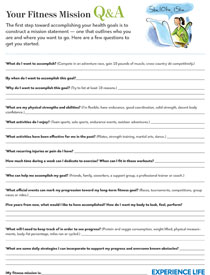To achieve any complex and challenging goal, it’s essential to establish clear objectives, address each obstacle systematically, regularly evaluate progress, and make adjustments as needed. The following six principles outline the foundation for crafting an effective fitness plan. Take the time to explore each of them:
1) Create a Mission Statement ⋅ 2) Take Inventory ⋅ 3) Make an Action Plan ⋅ 4) Do Your Accounting ⋅ 5) Manage Your Time ⋅ 6) Reassess and Recommit Quarterly
In business, planning is paramount. Whether lining up logistics, attending strategy meetings or digesting quarterly reports, savvy executives treat time as an ally, surveying the past for clear-eyed lessons about what worked and what didn’t, and looking forward for a chance to do it better next time.
At the gym, planning is too often an afterthought. Many of the same ambitious, practical people who divide their workdays into five-minute time blocks may amble aimlessly through their workouts like an office temp without a supervisor. They don’t know what tasks to perform, when to perform them or how to gauge success from day to day, let alone next week, next month or next year. “Most people never really get focused about fitness,” says Mike Robertson, MS, CSCS, co-owner of Indianapolis Fitness and Sports Training in Indianapolis. “They switch programs every few days or not at all. They miss workouts for weeks at a time.”
“Most people never really get focused about fitness. They switch programs every few days or not at all. They miss workouts for weeks at a time.”
As a result, no matter how earnest our intentions, many of us miss the mark. Not for lack of trying, but because we don’t have a winning blueprint or a strategy. “It’s only when you focus on one or two well-defined goals and follow a clear plan to accomplish them that you start to make real progress,” Robertson says.
Robertson, along with many other leading trainers, is articulating a fitness truth grounded in the basic tenets of business: If you want to accomplish any complex, challenging objective, you have to set clear goals, approach each of your hurdles systematically, routinely assess progress, and course-correct when necessary.
“When you go to the office, you don’t just show up and putter around. You go in with a plan, a series of tasks oriented toward a long-term goal,” says Chicago-based personal trainer Jim Karas, author of The Business Plan for the Body and The Petite Advantage Diet. “That’s how you should approach your fitness program as well.”
“When you go to the office, you don’t just show up and putter around. You go in with a plan, a series of tasks oriented toward a long-term goal. That’s how you should approach your fitness program as well.”
The payoff? If you walk through the gym doors armed with a solid strategy like the one outlined below, you’ll not only leave feeling satisfied with your efforts, you’ll also find yourself looking forward to moving your fitness game plan forward — week by week, month by month.
The best part: You’ll get the benefits of working for the world’s best boss. You.
1. Create a Mission Statement
Just as Ben and Jerry probably would have blown a gasket building computer software, and Bill Gates might have imploded dishing up ice cream, your fitness plans will most likely fizzle if you try to follow someone else’s dream or template. You need a big-picture approach that matches your interests, goals, lifestyle and passions.
The first step along the fitness path, then, is to create a fitness mission statement. What, exactly, do you want to accomplish, both in the short term (up to three months from now) and in the long term (a year or more from now)?
“Figuring out where you want to go with your fitness is hugely significant,” says Jolie Kobrinsky, CEO and co-owner of Prime Personal Training in Monterey, Calif. “You’re taking a vague inkling and making it concrete.”
Your vision can be athletic, aesthetic or both: You can set your sights on running a half-marathon or losing 25 pounds, earning a black belt or gaining slabs of lean muscle. You can choose almost anything, but it’s essential that you choose something, since the mission statement is your road map for success. It’s the “true north” toward which every workout, meal, food choice and recovery session should ultimately lead.
To get started on the process, think “S.M.A.R.T.” — a goal-setting acronym that stands for Specific, Measurable, Attainable, Realistic and Timely. In the business world, those are the goal-definition standards that help executives set well-defined agendas.
[Your] mission statement needs is passion. What gets you excited? What are you fired up to accomplish, learn or participate in?
For instance, “getting fit” is a commendable ambition, but it’s vague. Fit in what way, and by when? You’ll have a better shot succeeding if you aim for a clear and achievable target, like losing a belt size by summer or attending a fitness class twice a week for the next six weeks.
The other thing your mission statement needs is passion. What gets you excited? What are you fired up to accomplish, learn or participate in? If you’ve always wanted to dance the tango, learn to fence competitively or complete a mud-strewn adventure race, find out what sort of regimen is required and get to it.
“What you want in any fitness program,” says Robertson, “is skin in the game.” If you can’t come up with a substantial list of reasons why you want to realize a given goal, choose something else that pushes your buttons right now. In business, passion drives profits; in the gym, it drives progress.
(See the questions below in “Your Fitness Mission Q&A” to get started or download the PDF.)
2. Take Inventory
Once your mission statement is in ink (or stored on your hard drive), take some time to clearly look at your assets and liabilities: What do you have going for yourself, and where are you now, relative to where you want to be?
If you’re trying to change the way you look, take a “before” photo. If you want to finish stronger in your next 5K, use your heart-rate monitor’s stopwatch function on your next run and get a baseline. If you want to deadlift 300 pounds, get a clear sense of what your muscles can heft now.
While taking stock, consider not only your present physical condition but also what has worked for you historically. “A lot of answers can be found in your past,” says Linda Spangle, RN, MA, author of 100 Days of Weight Loss: The Secret to Being Successful on Any Diet Plan. So reflect on those periods when you’ve found success and enjoyment in your pursuit of fitness: Was it the era when you hit the gym every day before work? When you played on a team, worked out with a partner, trained for a competitive event?
At this stage, Karas also recommends that you “go public” with your goal: “Get your family and friends on board.”
It’s also wise to take inventory of any recurring injuries, pain and other functional limitations that might hold you back. Some of these problems might be obvious; others (like stiff hips or a tight back) might not be as evident, which is why doing an initial evaluation with a professional trainer can ultimately save you time and unnecessary setbacks. It can help you identify and remove any physical barriers to progress. “If a new client has movement or postural issues,” says Robertson, “I’d rather address that at the outset, before we jump into intense training.”
Finally, take stock of your available resources, including time, equipment and personnel: When do you have time to work out and prepare meals? Where can you find the necessary equipment? Do you need the support of a group, professional trainer or healthcare practitioner to help you get there? If so, who are those people and when can you see them?
At this stage, Karas also recommends that you “go public” with your goal: “Get your family and friends on board,” he says. That way they’ll do things like “bring you something healthy on your birthday instead of a triple-mocha cheesecake.”
3. Make an Action Plan
“The world gets out of the way for a man — or woman — with a plan,” says Karas, whose client list includes a host of Chicago’s most successful CEOs, plus celebrities like Diane Sawyer and Hugh Jackman. Just as a chief executive has to keep an eye on both short- and long-term goals, you need to think about daily to-dos and the big picture to make serious strides in your fitness objectives.
Whether you get the help of a pro at this stage or go it alone, always strive to break larger fitness goals into several smaller, more manageable bits. If you plan to do a triathlon this summer, start increasing your swim, bike and run distances now. If you’re trying to lose 20 pounds in 20 weeks, focus on dropping 5 pounds in five weeks.
A well-constructed fitness program is systematically progressive: You’ll gradually lift a little more, run a little farther or learn more skills over the course of time.
A well-constructed fitness program is systematically progressive: You’ll gradually lift a little more, run a little farther or learn more skills over the course of time.
Remember, though, that progress is never completely linear. Improvement in any physical endeavor resembles the stock market during a bullish period: a general trend upward with peaks and troughs appearing throughout. So it’s not important that you set a personal record every time you work out, just that over the long haul you get closer to achieving the objectives outlined in your mission statement.
As with almost any truly fruitful investment, you want to take the long view, and keep your focus on working your plan, week in, week out.
Ignore the get-fit-quick schemers who promise instant, spectacular returns — the kind that almost always end in injury, regained weight, undermined health or loss of interest.
“Too many people approach their fitness plan looking for the quick and easy payoff,” says Karas. “But the best results come when you’re slow and steady. Don’t be Bernie Madoff; be Warren Buffett.”
“Too many people approach their fitness plan looking for the quick and easy payoff. But the best results come when you’re slow and steady. Don’t be Bernie Madoff; be Warren Buffett.”
Remember, too, that a well-thought-out plan includes not just what to do in the gym, but also the smaller, behavioral strategies that make getting to (and through) your workout as easy as possible. “You want to remove the obstacles,” says Spangle. “I call it figuring out your ‘What It Takes’ list.”
For some people, that might mean laying out workout clothes the night before an early run or finding a gym that’s on the way home from work.
Elite-level ISSA trainer Angelo Poli, owner of Whole Body Fitness in Chico, Calif., requires his weight-loss clients to pack and carry an ice chest of food with them every day. “In my experience,” he says, “that’s the single action that makes the biggest difference for anyone trying to get and stay on a healthy eating plan.”
4. Do Your Accounting
Ultimately, success in any health and fitness program depends on hard data: mileage logged, weight lifted, nutrition consumed. By keeping track of the relevant numbers in a journal, you can celebrate successes, pick apart setbacks, and course-correct as you go.
For instance, maybe you’re dropping unwanted weight but you’re also feeling listless and struggling to build strength or endurance. If you’re keeping a food journal and a workout log, you can use the information and make small tweaks to your program, adding a little food, swapping some cardio for strength training to see what happens. But unless you have a decent record of what you’ve changed and how, you’ll have no clue what really worked, or why.
By keeping track of the relevant numbers in a journal, you can celebrate successes, pick apart setbacks, and course-correct as you go.
If keeping a journal helps, try ways to make the data crunching an enjoyable exercise. Spangle’s clients employ stickers on a calendar to keep themselves on course: “At the end of every day, put a green sticker on the calendar if you’ve adhered to your nutrition and fitness plan, a yellow sticker if you made a few mistakes, and a red sticker if you fell off completely. For best results, no fewer than 19 out of every 20 of those stickers should be green.”
Often, even the act of keeping notes is enough to effect a behavior change.
“Just keeping a precise food journal, without even trying consciously to change anything, can make a huge difference in your diet,” Robertson says, “because it makes you think about what you’re doing.”
Think of it this way: If you’re at a party and faced with a big bowl of tortilla chips, you’re less likely to overindulge if you’re keeping track of every chip you pilfer.
5. Manage Your Time
Lack of time is one of the main reasons people cite for not exercising. They can’t see any way to fit a few hours a week of exercise into an already-crammed schedule. Generally, though, that’s bunk.
“When people tell me they don’t have time to work out,” says Robertson, “I’ll ask them for a daily schedule in which they account for every 15-minute chunk of time during waking hours. Most people don’t even have to fill it out before they realize their real problem is too much Facebook and TV.” By trading lower-value pastimes for top-priority self-care, he notes, most people stand to gain not just vitality, but also an enhanced sense of focus and self-respect.
By trading lower-value pastimes for top-priority self-care, most people stand to gain not just vitality, but also an enhanced sense of focus and self-respect.
How many minutes, hours and days you need to train also depends on the contents of your mission statement. For most people with general fitness-improvement and weight-loss goals, three hourlong workouts a week on nonconsecutive days, including some intensive interval training, does the trick, Poli says. “With those types of workouts, you’re combining cardiovascular training and strength work. You’ll stimulate your largest muscle fibers while deriving a huge cardiovascular benefit at the same time.”
If you have serious, sports-specific performance goals, you may need to commit more time. But contrary to popular belief, unless you’re training for an endurance event, long, slow cardio exercise generally isn’t necessary and may actually work against building muscle mass. “Muscle mass is your fitness capital,” says Karas. “You want to do everything you can to preserve it.”
When you are seriously strapped for time or low on energy, Spangle suggests the “10-Minute Solution”: “Tell yourself you’re just going to exercise for 10 minutes. Often, after 10 minutes you’ll have overcome your resistance and will want to keep going. But if you stop for the day at that point, that’s fine, too. Either way, you’ve been successful.”
6. Reassess and Recommit Quarterly
In fitness, just as in business, you have to take stock at regular intervals. Once a quarter, either on your own or with a trainer, assess how you’re doing.
“Meeting a goal can be tremendously empowering,” says Kobrinsky. And periodic check-ins can spark a well-deserved mini-celebration.
Seeing that you’re falling short of a goal can be instructive as well. Was your plan itself ineffective? Was it too restrictive, time consuming and impossible to follow? Did work obligations, family stress or other distractions prevent you from fully committing to it? If so, don’t throw out the whole endeavor — simply rework your plan to better suit your current schedule and obligations.
“Perfectionism can be a real obstacle,” says Spangle. “People try to do these complex, time-consuming programs and decide that if they can’t follow them to the letter, they won’t follow them at all. It’s much better to be successful on a slightly less ambitious program.”
Whether you meet, exceed or fall a little shy of your fitness goals at any given time, it’s important to either recommit or thoughtfully reconsider your approach.
Whether you meet, exceed or fall a little shy of your fitness goals at any given time, it’s important to either recommit or thoughtfully reconsider your approach. Give some thought to what you most want to accomplish now, and how you might best be able to move toward that goal in the short term.
“After accomplishing a goal, most of my clients go through a doldrums period,” says Robertson. “They’re less fired up in the gym, less strict with their diet. That’s when I try to help them find something new that they’re excited about. If they’ve had a physique goal, for example, I try to get them to consider a performance goal.”
What’s important is that you keep your eyes on the prize, and your head in the game. When in doubt, go back to the mission statement that fired you up in the first place.
“Not every company can be Apple,” says Kobrinsky. “Just like not everyone will become an Olympic athlete. But companies that invest in quality, dependability and durability over the long haul typically find great success. By using that same strategic, committed approach to training, we can build great bodies, too.”
Your Fitness Mission Q&A
The first step toward accomplishing your health goals is to construct a mission statement — one that outlines who you are and where you want to go. Here are a few questions to get you started.
- What do I want to accomplish? (Compete in an adventure race, gain 10 pounds of muscle, cross-country ski competitively.)
- By when do I want to accomplish this goal?
- Why do I want to accomplish this goal? (Try to list at least 10 reasons.)
- What are my physical strengths and abilities? (I’m flexible, have endurance, good coordination, solid strength, decent body confidence.)
- What activities do I enjoy? (Team sports, solo sports, endurance events, outdoor adventures.)
- What activities have been effective for me in the past? (Pilates, strength training, martial arts, dance.)
- What recurring injuries or pain do I have?
- How much time during a week can I dedicate to exercise? When can I fit in those workouts?
- Who can help me accomplish my goal? (Friends, family, coworkers, a support group, a professional trainer or coach.)
- What official events can mark my progression toward my long-term fitness goal? (Races, tournaments, competitions, group races or rides.)
- Five years from now, what would I like to have accomplished? How do I want my body to look, feel, perform?
- What will I need to keep track of in order to see progress? (Protein and veggie consumption, weight lifted, physical measurements, body-fat percentage, miles run or cycled.)
- What are some daily strategies I can incorporate to support my progress and overcome known obstacles?
Your Fitness Mission PDF
This article has been updated. It originally appeared in the January/February 2013 issue of Experience Life magazine.






This Post Has One Comment
Your information is very informative …..its knowledgeable with great tips …… it help me a lot ….. thank you for motivation for stay more fit …